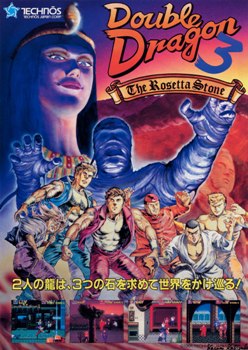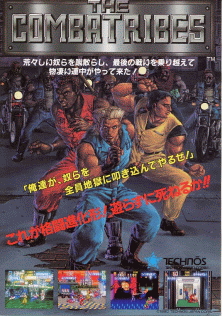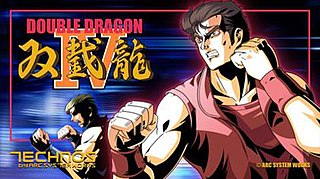
River City Ransom, known as Street Gangs in PAL regions, is an open world beat 'em up video game originally for the Nintendo Entertainment System. It is an English localization of Downtown Nekketsu Monogatari for the Famicom. The game was developed by Technōs Japan and released in Japan on April 25, 1989.

Technōs Japan Corp. was a Japanese video game developer, best known for the Double Dragon and Kunio-kun franchises as well as Karate Champ, The Combatribes and Voltage Fighter Gowcaizer. As of June 2015, Arc System Works owns the intellectual properties of Technōs Japan.

Double Dragon is a beat 'em up video game series originally developed and published by Technōs Japan. It began with the release of the arcade game Double Dragon in 1987. The series features twin martial artists, Billy and Jimmy Lee, as they fight against various adversaries and rivals.

Super Double Dragon, released in Japan as Return of Double Dragon: "Sleeping Dragon" has Awoken, is a side-scrolling beat-'em-up released for the Super Nintendo Entertainment System in 1992. It was published by Tradewest in North America and the PAL region and by Technōs Japan in Japan. Super Double Dragon is the fourth console game in the Double Dragon series developed by Technōs Japan, following Double Dragon III: The Sacred Stones for the NES. The game did not have an arcade release and was made specifically for the home market.

Double Dragon II: The Revenge is a side-scrolling beat 'em up produced by Technōs Japan originally released as a coin-operated arcade game in 1988. It is the first sequel to Double Dragon, released during the previous year. The sequel involves Billy and Jimmy Lee in a mission to avenge Billy's girlfriend Marian after she is shot to death by the Black Warriors leader Willy, who is retaliating against the Lee brothers after his defeat at the end of the previous game. Double Dragon II was initially developed as an upgrade kit for the original Double Dragon, but evolved into a stand-alone game due to an increase in memory size, resulting in the developers reusing assets for both games.

Double Dragon 3: The Rosetta Stone is a side-scrolling beat 'em up arcade game produced by Technōs Japan in 1990. It is the third arcade game in the Double Dragon series. Unlike the previous two games in the series, Double Dragon 3 was not developed internally at Technōs, but development was instead contracted to the company East Technology, resulting in a game that looks and plays differently from its predecessors.

Bad Dudes Vs. DragonNinja, also known simply as either Bad Dudes or DragonNinja, is a side-scrolling cooperative beat 'em up game developed and released by Data East for arcades in 1988. It was also ported to many computer and game console home systems.

Kung-Fu Master, known as Spartan X in Japan, is a side-scrolling beat 'em up developed by Irem as an arcade video game in 1984, and distributed by Data East in North America. Designed by Takashi Nishiyama, the game was based on Hong Kong martial arts films. It is a loose adaptation of the Jackie Chan, Sammo Hung, and Yuen Biao film Wheels on Meals (1984), called Spartan X in Japan, with the protagonist Thomas named after Jackie Chan's character in the film. The game is also heavily inspired by the Bruce Lee film Game of Death (1972), which was the basis for the game's concept. Nishiyama, who had previously designed the side-scrolling shooter Moon Patrol (1982), combined fighting elements with a shoot 'em up gameplay rhythm. Irem and Data East exported the game to the West without the Spartan X license.

Nekketsu Kōha Kunio-kun, released as Renegade in the West, is a beat 'em up video game developed by Technōs Japan and distributed by Taito for the arcades in 1986. In the original Japanese version Nekketsu Kōha Kunio-kun, the game revolves around a high-school delinquent named Kunio-kun who must stand up against a series of rival gangs frequently targeting his classmate Hiroshi. In the Western version Renegade, the player controls a street brawler who must face four different gangs in order to rescue his girlfriend being held captive by a mob boss.

Double Dragon III: The Sacred Stones, released in Japan as Double Dragon III: The Rosetta Stone (ダブルドラゴンIII ザ・ロゼッタストーン), is a side-scrolling beat-'em-up produced for the Nintendo Entertainment System in 1991. It was the third Double Dragon game for the NES, developed by Technos Japan Corp. and published in North America and Europe by Acclaim Entertainment. Although loosely based on the similarly titled arcade game Double Dragon 3: The Rosetta Stone, it is not a port, but a parallel project that was developed at the same time.

Torneko: The Last Hope is a 1999 role-playing video game for the PlayStation. The game was co-developed by Chunsoft and Matrix Software and published by Enix. In Japan, the game was ported to the Game Boy Advance in 2001.

Double Dragon is a 1995 fighting video game spin-off of the Double Dragon series developed and published by Technōs Japan. It is based on the 1994 film, which in turn was based on the original arcade game. It was originally released for the Neo Geo and later released for the Neo Geo CD and PlayStation. It was Technōs Japan's last Double Dragon game before the company went out of business, and the fourth and final Double Dragon game released in arcades.

Double Dragon is a 1987 beat 'em up video game developed by Technōs Japan and distributed by Taito for arcades across Asia, North America and Europe. It is the first title in the Double Dragon franchise. The game's development was led by Yoshihisa Kishimoto, and it is a spiritual and technological successor to Technos' earlier beat 'em up, Nekketsu Kōha Kunio-kun (1986), released outside of Japan by Taito as Renegade; Kishimoto originally envisioned it as a direct sequel and part of the Kunio-kun series, before making it a new game with a different cast and setting.

Target: Renegade is a beat'em up video game released on the Amstrad CPC, Commodore 64 and ZX Spectrum systems in the late 1980s by Ocean Software on their "Imagine" label, as well as a Nintendo Entertainment System version published by Taito. The game is a sequel to Renegade and was followed by Renegade III: The Final Chapter. When acquiring the license to convert the original arcade game Renegade to home computers, Ocean acquired the option to produce and release their own home-computer-only sequels to the game, and Target Renegade was the first of these sequels.

Dragon Ball: Advanced Adventure is a 2004 video game released for Game Boy Advance based on the Dragon Ball franchise.

The Combatribes is a 1990 beat 'em-up game released for the arcades by Technos Japan Corp. A home version for the Super Nintendo Entertainment System was also released in 1992. The game centers on three vigilantes who must fight against numerous street gangs in futuristic New York City. The SNES version was released for the Wii Virtual Console in North America on November 30, 2009.

Advance Guardian Heroes is a beat 'em up video game developed by Treasure for the Game Boy Advance. The game was released on September 22, 2004, in Japan, September 14 in North America and February 18, 2005, in Europe. The Japanese version was self-published by Treasure, while the American and European editions of the game are published by Ubisoft.

Abobo's Big Adventure is a freeware parody flash game. Inspired by various video games released for the Nintendo Entertainment System, the game features Abobo, a boss character from the Double Dragon franchise, traveling through the worlds of several different games to save his son. Written by I-Mockery.com founder Roger Barr, programmed by Nick Pasto, with art and animation by PoxPower, Abobo's Big Adventure was released in January 2012 to positive critical reception.

Double Dragon II: The Revenge is a side-scrolling beat-'em-up produced for the Nintendo Entertainment System in late 1989. It is the second Double Dragon game for the NES and was published in North America by Acclaim Entertainment, who took over publishing duties from Tradewest. The game shares its title with the 1988 arcade sequel to the original Double Dragon, using the same promotional artwork for its packaging and having a similar plot, but the content of the two games are otherwise drastically different. The NES version of Double Dragon II was directed by Hiroyuki Sekimoto, with the arcade version's director Yoshihisa Kishimoto taking a supervisory role in the game's development.

Double Dragon IV is a beat 'em up video game developed and published by Arc System Works for PlayStation 4, Windows, Nintendo Switch, and Xbox One. It is part of the Double Dragon series.





















